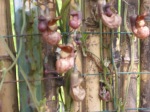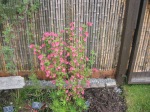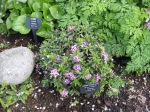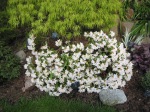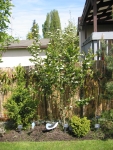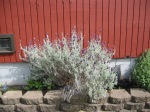
Here I am with a flat of tomato seedlings I started from seed in the greenhouse a few weeks ago. They’ll be ready to plant out next weekend on Mother’s Day. They should be safe from late frosts by then. It’s a wonderful time of year to be in out in our little Wildlife Nature Sanctuary and Garden. And to add to the attraction – today is World Naked Gardening Day! It was started in 2005 by some “naturists” right here in Seattle as a project of Body Freedom Collaborative. Since then it has become a world-wide phenomenon in gardens and parks everywhere. It’s always held on the first Saturday in May, tho the folks “down under” do it in late October.
According to the WNGD.org website:
Why garden naked? First of all, it’s fun! Second only to swimming, gardening is at the top of the list of family-friendly activities people are most ready to consider doing nude. Moreover, our culture needs to move toward a healthy sense of both body acceptance and our relation to the natural environment. Gardening naked is not only a simple joy, it reminds us–even if only for those few sunkissed minutes–that we can be honest with who we are as humans and as part of this planet.
“Sweet, sane, still Nakedness in Nature! –ah if poor, sick, prurient humanity in cities might really know you once more! Is not nakedness then indecent? No, not inherently. It is your thought, your sophistication, your fear, your respectability that is indecent. There come moods when these clothes of ours are not only too irksome to wear, but are themselves indecent. Perhaps indeed he or she to whom the free exhilarating ecstasy of nakedness in Nature has never been eligible (and how many thousands there are!) has not really known what purity is–nor what faith or art or health really is.” Walt Whitman, Specimen Day.

Taking a break from edging the lawn. I always do it by hand so it comes out nice and clean, and I can remove the grass that keeps trying to take over the planting beds. Yes, I wear sunscreen, at the behest of my dermatologist, who warned me that I’d better be more careful, or I’d end up back at his office with more a serious complaint than a check up! I generally wear a hat that helps keep my head shaded and cooler. The sun gets hot when you’re down on your knees like this. It feels so good to be naked in my own garden. My neighbors are pretty cool, and we have a lot of privacy, but it’s not a big deal really, as it’s legal to be nude in public here in Seattle, as long as you’re not indecent or obscene, or around kids, of course. The police don’t really bother with it unless you break the law. Since I’m in my own yard on my own property I can do it with impunity and not fear any consequences, even if I get “caught”. 😉
“When you’re out there with a gentle breeze on you, every last hair on your body feels it. You feel completely connected with the natural world in a way you just can’t in clothes.” Barbara Pollard, of Abbey House Gardens

I’m tending some Russian Red Kale we planted late last summer. Over wintering it gives it such a sweet flavor, thanks to the frosts and cold of winter. We’ve been eating off this patch for awhile now and can do so for some time yet. I keep the flower buds trimmed off so it won’t bloom and we can keep getting more leaves to eat. Yum! We’ve also got onions and peas growing so far this year, with corn and tomatoes ready to go soon. We get a lot of good food from our little veggie gardens. We’re still eating the carrots and onions we grew last year! We stored the carrots in sand last fall, and they kept perfectly! This was a new method for us and we’ll do it again this year, as well as keep some in the ground to harvest as we need them.
“The body seems to feel beauty when exposed to it as it feels the campfire or sunshine, entering not by the eyes alone, but equally through all one’s flesh like radiant heat, making a passionate ecstatic pleasure glow not explainable.” John Muir, founder of The Sierra Club

Like I said – it gets pretty hot when you’re down close to the ground like this. I can feel the heat of the sun just baking into my back as I weed the flower bed here. I’ve planted all sorts of flower seeds here, and most of them are coming up. I’ll have to do some thinning so they won’t be too crowded. This bed is always so beautiful as summer progresses and it fills with blooms of all sorts. I see lots of Bee’s Friend coming up, as well as China Asters, Sunflowers and Opium Poppies (yes, they’re legal to grow, as long as you don’t harvest the sap!).
From the WNGD.org website again:
All that’s involved is getting naked and making the world’s gardens–whatever their size, public or private–healthier and more attractive. WNGD has no political agenda, nor is it owned or organized by any one particular group. Naked individuals and groups are encouraged to adopt the day for themselves.
Events like WNGD can help develop a sense of community among people of every stripe. Taking part in something that is bigger than any one household, naturist group, or gardening club can move gardeners with an au naturel joie de vivre toward becoming a community. And in the case of WNGD, it’s fun, costs no money, runs no unwanted risk, reminds us of our tie to the natural world, and does something good for the environment.

Finally, in some shade in the center of the garden at last! This area has become so special to me. It’s like being in a secluded glade in the forest with all the ferns and conifers as well as numerous flowers. You can see the large leaves of the Wild Ginger at the bottom of the photo, with the Bleeding Heart blooming above it, and the Kelley’s Prostrate Redwood at the left side. You can also just see the edge of the fountain here too. When it’s on it fills the whole garden with its gentle gurgling sound, reminiscent of a small brook or stream. It makes the air feel cooler too, and the birds love to play in the water as they fill the air with their lovely sounds. It’s a nice place to be naked – you feel so connected to all the plants and the water, and all of Nature. Without the barriers of clothing you feel like you really belong here. It’s truly a healthy pastime, good for both your physical and your mental health. I’ve been a nudist my whole life and lately it’s become a passion for me to garden naked, and I’ve been going outside and doing it as often as I can. The warming days of Spring provide enough heat to make it not only comfortable, but enticing as well. It’s so easy to immerse yourself in it and just let your energies flow unimpeded…
Walt says it best:
I will go to the bank by the wood and become undisguised and naked, : I am mad for it to be in contact with me. Walt Whitman: From Song of Myself (1855)
If you haven’t tried gardening naked I heartily suggest you give it a try. You may be surprised at how good it can make you feel about yourself to be at one with your garden like this. It feels like all the plants are in harmony with you and the whole of Nature fills you with an ecstatic joy! I am mad to merge with it!
Feel the Sun on your beautiful body!
Steve




















































































































































